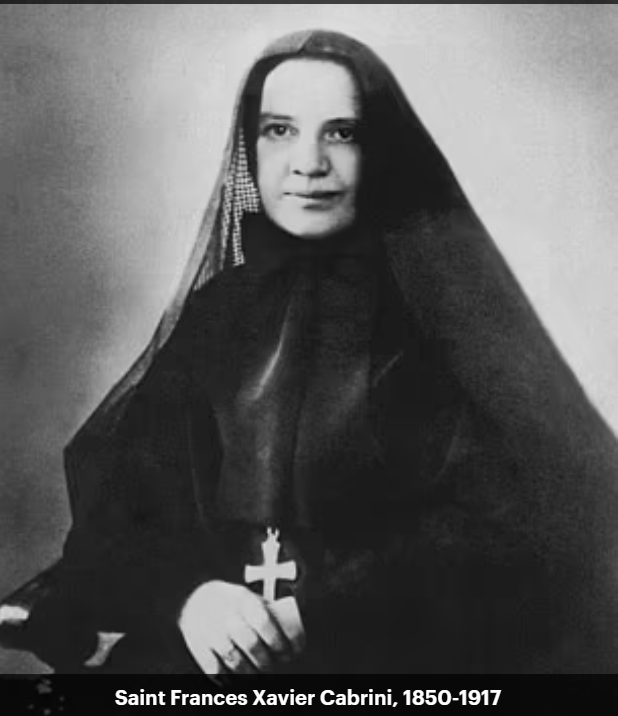After thousands of faithful believers flocked to an abbey in Missouri to see the remarkably preserved remains of a Catholic nun who died four years ago, some are suggesting is a sign she should be considered for sainthood. Sister Wilhelmina Lancaster, who died in 2019, has not yet reached the required minimum of five years since death for the Catholic Church’s lengthy and complex sainthood process to begin. Still, the incident is drawing attention to the history of sainthood in the US. In all, there are only 11 Catholic saints who have been canonized for their work in what is now the United States.
Lancaster founded the Benedictines of Mary, Queen of Apostles religious order in Gower, Missouri, and died four years ago at age 95. The nuns of the order say that Lancaster’s body was being reinterred to make way for a construction project, and that they had only expected to find bones, because she had been buried in a simple wooden coffin without any embalming. Instead, they discovered an intact body and ‘a perfectly preserved religious habit,’ the order’s statement said.
The nuns hadn’t meant to publicize the discovery, but someone shared a private email publicly and ‘the news began to spread like wildfire.’
Lancaster’s body was placed in a glass shrine in the abbey’s church on Monday, with Catholic News Agency reporting an estimated 1,000 cars arrived for the ceremony. The local diocese said it will investigate, but warned that Lancaster’s remains should not be venerated or treated as relics in the meantime.
‘The Church has an established process for determining if someone is a saint and worthy of veneration. No such process has yet been initiated on behalf of Sister Wilhelmina,’ said Kansas City Bishop James V. Johnston Jr. in a statement. Though the relative preservation of Lancaster’s body has drawn intense interest from the faithful, experts say that it is not unheard of for human remains to stay relatively intact for years, even without embalming.
The Catholic canonization process requires an investigation into the candidate’s life and death, to determine whether they were either martyred or lived a virtuous life. Following the investigation at the diocese level, the Vatican’s Congregation for the Causes of Saints examines the report and makes a recommendation to the pope, who may then declare the person ‘Venerable’.
The next step, in which the pope declares the person ‘Blessed’, requires at least one miracle attributed to the person by church investigators. A second miracle is required to be elevated from ‘Blessed’to ‘Saint’.
Here are the 11 people who have been canonized as saints for their work in the lands that are now part of the United States:
Saint Isaac Jogues, 1607-1646
Feast day: October 19
Jogues, a French missionary, is the patron saint of the Americas and Canada. A Jesuit priest who was ordained in 1636, he traveled to the French colonies in North America in a bid to convert Native Americans to Christianity. In 1642, he was captured and tortured by Mohawk Indians near present-day Auriesville, New York, and watched as other members of his party were put to gruesome deaths. After more than a year of captivity, he escaped and returned to France aboard a Dutch ship. Despite his ordeal, Jogues volunteered to return to the New France territory as an emissary to broker peace with his former captors. ‘My heart tells me that, if I am the one to be sent on this mission, I shall go but I shall not return. But I would be happy if our Lord wished to complete the sacrifice where he began it,’ he explained in a letter. His prediction was correct, and he was killed with a tomahawk in 1646. Jogues was canonized a saint in 1930 by Pope Pius XI.
Saint Kateri Tekakwitha, 1656-1680
Feast day: July 14
Tekakwitha was born in a Mohawk village located in what is today New York state, and was orphaned at the age of four when her parents died of smallpox. She converted to Catholicism at age 19, and took a vow of perpetual virginity. Tekakwitha moved to a small Jesuit village near present-day Montreal and lived out her remaining years there before dying age 24. Tekakwitha was canonized a saint in 2012 by Pope Benedict XVI.
Saint Junípero Serra, 1713-1784
Feast day: July 1
Serra was a Spanish Catholic priest and missionary of the Franciscan Order. He led a group that founded missions in what is today Mexico and California. His canonization faced protests from Native American groups, who argued that he led a brutal campaign of subjugation. Serra was canonized a saint in 2015 by Pope Francis.
Saint Rose Philippine Duchesne, 1769-1852
Feast day: November 18
Duchesne was a French religious sister and educator who immigrated to American in 1818. She settled in what was then the Missouri Territory, and ministered to Native Americans who had been displaced from their ancestral homelands by government removal programs. She continued her ministry in Kansas and opened the first free school for girls west of the Mississippi river, as well as the first Catholic school for Native Americans. Duchesne’s was known among the Pottawatomie tribe as Quahkahkanumad, which means the ‘woman who prays always’. She died in 1852 at age 83. She was canonized a saint in 1988 by Pope John Paul II.
Saint Elizabeth Ann Seton, 1774-1821
Feast day: January 4
Seton was a religious sister and educator born in New York City, and known as a founder of the US parochial school system. Raised in a wealthy and prominent family, Seton converted to Catholicism following her husband’s death in 1803. She later moved to Maryland and established the Saint Joseph’s Academy and Free School, a school dedicated to Catholic girls’ education, and founded the Sisters of Charity of St. Joseph’s. The Sisters of Charity helped launch orphanages and schools across the country, and six congregations trace their roots to the order. Seton was canonized a saint in 1975 by Pope Paul VI.
Saint Mother Theodore Guerin, 1798-1856
Feast day: October 3
Guerin was a French nun who immigrated to Indiana in 1840, and was known for founding numerous schools and caring for the sick and dying. She founded the the Sisters of Providence of Saint Mary-of-the-Woods congregation in Indiana, and opened schools in Illinois and throughout Indiana. She founded Saint Mary’s Academy for young women, the forerunner of Saint Mary-of-the-Woods College, today the oldest Catholic college in Indiana. Guerin was canonized a saint in 2006 by Pope Benedict XVI.
Saint John Neumann, 1811-1860
Feast day: January 5
Born in Bohemia, Nuemann immigrated in 1836 to the United States, where he was ordained a priest and became Bishop of Philadelphia. Neumann founded the first Catholic diocesan school system in the US. A fluent speaker of both German and Italian, he was known for his work in Philadelphia’s immigrant communities. Neumann was known for his frugality, and over the two decades he lived in the US, he owned and wore only one pair of boots. He was also famous for giving away any new vestments he received to newly ordained priests. Neumann was canonized a saint in 1977 by Pope Paul VI.
Saint Marianne Cope, 1838-1918
Feast day: January 23
Cope was a German-born religious sister who joined the Sisters of St Francis of Syracuse, New York after immigrating to America. She helped found the St. Joseph’s Hospital in Syracuse, and in 1883 she relocated to Hawaii, where she helped care for people suffering from leprosy. Cope answered a plea from King Kalkaua of Hawaii to care for leprosy sufferers on the islands, after more than 50 religious congregations refused his request. Despite her extensive contact with leprosy sufferers, Cope never contracted the disease. She was canonized a saint in 2012 by Pope Benedict XVI.
Saint Damien de Veuster, 1840-1889
Feast day: May 10
Veuster was a contemporary of Cope, who worked with the nun to help the sick and suffering in Hawaii. Born in Belgium, he entered the Congregation of the Sacred Hearts of Jesus and Mary when he was 19. During his religious studies, Veuster prayed daily before a picture of St. Francis Xavier, patron of missionaries, to be sent on a mission. When his brother, an ordained priest, fell ill and was unable to travel to Hawaii on a mission, Veuster volunteered to take his place in 1864. Veuster dedicated himself to living permanently in a leper colony on the island of Molokai, where he built schools, churches and hospitals. He was later joined there by Cope. Veuster contracted leprosy himself, but continued to serve the mission until his death in 1889. He was canonized a saint in 2009 by Pope Benedict XVI.
Saint Frances Xavier Cabrini, 1850-1917
Feast day: November 13
Known as Mother Cabrini, she was born in Italy and took religious vows there in 1877. In 1880, Cabrini and seven other women who had taken religious vows with her founded the Missionary Sisters of the Sacred Heart of Jesus. She had hoped to lead a mission to China, but instead the pope urged her to go to the United States to help Italian immigrants who were migrating there in huge numbers. She arrived in New York in 1889 and organized catechism and education classes for the Italian immigrants, also caring for many orphans. She founded Columbus Hospital in New York, and later moved to Chicago and founded hospitals serving immigrants there. Cabrini died in Chicago in 1917 while preparing Christmas candy for children there. She was the first United States citizen to be canonized, and is known as the patron saint of immigrants. Her name lives on in Chicago’s Cabrini Street and Cabrini Boulevard in New York. Cabrini was canonized as a saint in 1946 by Pope Pius XII.
Saint Katharine Drexel, 1858-1955
Feast day: March 3
Drexel was born in Philadelphia to a prominent Catholic family that owned a considerable banking fortune. She initially took religious vows with the Sisters of Mercy in Pittsburgh. In 1891, she founded the Sisters of the Blessed Sacrament, a religious order serving black people and Native Americans in the southern and western US. She financed more than 60 missions and schools around the United States, and founded Xavier University in Louisiana, the country’s the only historically black Catholic university. Across the US, scores of Catholic parishes and schools are named after Drexel today. She was canonized as a saint in 2000 by Pope John Paul II.
Source: | This article originally belongs to Dailymail.co.uk.


Thank you for the list of American saints. My sister has canonized my mother as another American saint. God bless!
My Fahter died 2019 he is saint Francis Xavier parish healer like Jesus raising dead casting demons everything he died the world collapsed coz I have universal energy Holy Spirit I called Catholic Church but they don’t know anything I’m sure I am the saint in the middle of Muslim and Christian I am 524 years old now this coming Dec 3 2024 my parents born after Cabrini beatified my father Dec 2 and 3 saint Francis Xavier parish healer for 80 years my mother may 8 saint Micheal healer I am the lady of the face eternal life gifted after my father death I’m here in the kingdom of god founding companion society of Jesus all my co worker the birthday is like muchpartner all I can see reality god creation everything is computerized and my actual life the same. I can heal casting out and mostly god creation my parents is belongs to saint Cabrini
I am eternal life Christianity gifted after my Fathers death o am 524 years old this coming Dec 3 2024 Saint Francis Xavier parish